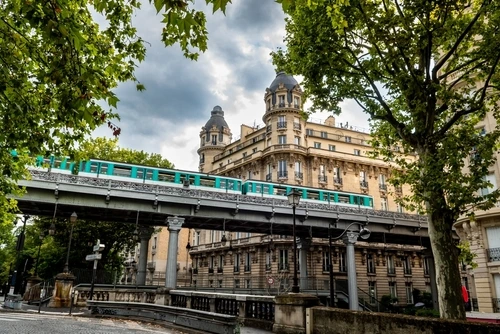
If you plan to use the Paris Metro on a visit to the French capital soon, it may be an unfamiliar feeling for those used to riding the tubes and subways of London and New York. Here are the seven things you need to know.

Handles
New trains have automatic doors; a second type has a green button. However, a third type has handles that you have to use in order for the doors to open, lifting the small piece of metal up slowly as you’re unsure if you’re going to break the train or lose your arm, only for the doors to snap open rapidly and viciously. You’re left standing confused and bemused, buffeted by the heavy station air – all while being furiously judged by Parisians.
Most Parisians are lovely, but when you see seasoned Paris Metro veterans lifting the handle well ahead of time as the train coasts into the station, waiting impatiently for the hiss of the unlocking mechanism, it’s hard not to feel intimidated. Your average Briton, on the other hand, can be relied upon to stare at the door, willing it to open automatically, only to miss their stop as the train rolls away.
It’s also worth noting that the doors open before the train has stopped moving. TfL officials would have kittens.
Double-deckers on the Metro
Some of the trains in Paris are double-deckers and, here, that’s completely normal. Picturing such trains overground might be an easier imaginative leap for Tube-dwellers, but when you see one underground for the first time it’s a truly disarming experience.
These double-deckers are reserved for the busiest lines, running on the RER network, separate to (but overlapping with) the 16 normal single-decker Paris Metro lines. Taking your seat on the upper deck is a disconcerting feeling at first, but when you’re almost guaranteed a seat and get a novelty experience in the bargain, it’s hard to complain.
Paris’s numbers and names
Part of the quaintness of the Tube is the line names, and the weird, almost-nationalism attached to whichever one you call home. But in Paris, the lines are just numbers. Boring, coloured numbers.
Station names, however, are amazing. Sure, there’s standard fare that you’d expect from tube stops around a capital city, with Bastille, République, Europe and Nation reflecting the squares from which they take their name. But Paris has a delightful little idiosyncrasy that London doesn’t have at all: the Parisians who mapped out the metro lines obviously had a real penchant for naming stations after famous figures.
You’ve got legendary authors, like Victor Hugo (Les Misérables) and Alexandre Dumas (The Three Musketeers). You’ve got a station named after Pablo Picasso. You’ve got political figures, like Robespierre and, somewhat oddly, Franklin D. Roosevelt. (You can already see President Macron rubbing his hands at the thought of having a station named after him in 50 years’ time.)
Parmentier is named after the guy who discovered potatoes and brought them to France, saving thousands of Parisians’ lives during a time of famine. There’s even a little statue of him giving a potato to an impoverished man. Inspiring stuff.
The Navigo pass for the Paris Metro
There’s no beating around the bush: the Parisian equivalent of the Oyster is a mess. For a start, there are two of them, with confusing and barely-existent differences between them. There’s the carte Navigo and the carte Navigo Découverte (“discovery”), which costs €5 upfront.
It’s a confusing system that needlessly complicates navigating the Paris Metro. However, travelling around the Paris Metro has become easier thanks to the introduction of a contactless pay-as-you-go card for visitors, the Navigo Easy.
Manual gates at stations
Speaking of which, we need to talk about Paris’ metro gates. Some of them are manual, making you feel less like you’re travelling underground in a major European city, and rather like you’re passing through the turnstiles at an old football ground.
You have to push through the turnstile, and then push through the weird flappy door-gate thing just behind it. Don’t incorrectly presume that it is automatic and that your Navigo hadn’t worked before turning around and walking away.
Advertising on the Paris Metro
We’re all used to seeing movie posters and “this amazingly well-produced photo was shot on an iPhone that you can’t afford” ads lining Tube tunnels, but Paris has taken capitalism to a new level. An entire station could be one massive video game advert.
Older trains and fewer peoples
Some of the trains running are old. Creakingly, achingly old. If you look in the corner of a carriage, you can see disused screens from the past with manually-operated lights telling you which stop you’re approaching, like those on the front of old buses.
Combined with the handles and some suspiciously flickering lights, you’re one steam engine away from a strangely antiquated experience. It’s cute – if a little inefficient. You can’t help but suspect that the Paris Metro has had far less money pumped into it than the Tube over the years.
The Paris Metro certainly takes some getting used to. Yet for all its strangeness, the experience is a positive one – it’s still a fantastic way around the city.
It’s also a reassuringly universal one. In London and Paris alike, there are cramped rush hours, efficient trains and – yes – incessant reminders to mind the bloody gap.
[Read more: Germany’s €9 public transport ticket increases to €49]






